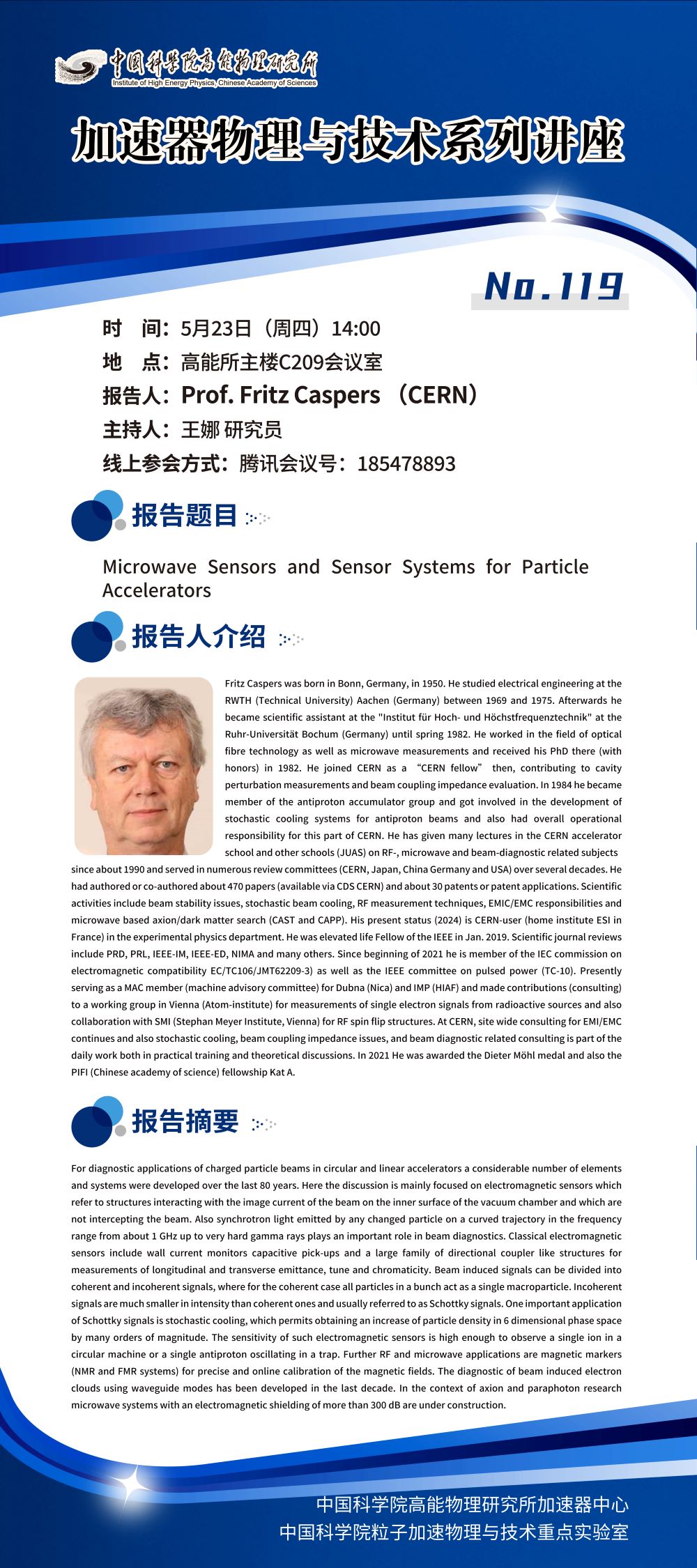时间:5月23日(周四)14:00
地点:高能所主楼C209会议室
报告人:Prof. Fritz Caspers (CERN)
主持人: 王娜 研究员
线上参会方式:腾讯会议号:185478893
报告题目:
Microwave Sensors and Sensor Systems for Particle Accelerators

报告摘要:
For diagnostic applications of charged particle beams in circular and
linear accelerators a considerable number of elements and systems were developed over the last 80 years. Here the discussion is mainly focused on electromagnetic sensors which refer to structures interacting with the image current of the beam on the inner surface of the vacuum chamber and which are not intercepting the beam. Also synchrotron light emitted by any changed particle on a curved trajectory in the frequency range from about 1 GHz up to very hard gamma rays plays an important role in beam diagnostics. Classical electromagnetic sensors include wall current monitors capacitive pick-ups and a large family of directional coupler like structures for measurements of longitudinal and transverse emittance, tune and chromaticity. Beam induced signals can be divided into coherent and incoherent signals, where for the coherent case all particles in a bunch act as a single macroparticle. Incoherent signals are much smaller in intensity than coherent ones and usually referred to as Schottky signals. One important application of Schottky signals is stochastic cooling, which permits obtaining an increase of particle density in 6 dimensional phase space by many orders of magnitude. The sensitivity of such electromagnetic sensors is high enough to observe a single ion in a circular machine or a single antiproton oscillating in a trap. Further RF and microwave applications are magnetic markers (NMR and FMR systems) for precise and online calibration of the magnetic fields. The diagnostic of beam induced electron clouds using waveguide modes has been developed in the last decade. In the context of axion and paraphoton research microwave systems with an electromagnetic shielding of more than 300 dB are under construction.
报告人简介: Fritz Caspers
Fritz Caspers was born in Bonn, Germany, in 1950. He studied electrical engineering at the RWTH (Technical University) Aachen (Germany) between 1969 and 1975. Afterwards he became scientific assistant at the "Institut für Hoch- und H?chstfrequenztechnik" at the Ruhr-Universit?t Bochum (Germany) until spring 1982. He worked in the field of optical fibre technology as well as microwave measurements and received his PhD there (with honors) in 1982. He joined CERN as a “CERN fellow” then, contributing to cavity perturbation measurements and beam coupling impedance evaluation. In 1984 he became member of the antiproton accumulator group and got involved in the development of stochastic cooling systems for antiproton beams and also had overall operational responsibility for this part of CERN. He has given many lectures in the CERN accelerator school and other schools (JUAS) on RF-, microwave and beam-diagnostic related subjects since about 1990 and served in numerous review committees (CERN, Japan, China Germany and USA) over several decades. He had authored or co-authored about 470 papers (available via CDS CERN) and about 30 patents or patent applications. Scientific activities include beam stability issues, stochastic beam cooling, RF measurement techniques, EMIC/EMC responsibilities and microwave based axion/dark matter search (CAST and CAPP). His present status (2024) is CERN-user (home institute ESI in France) in the experimental physics department. He was elevated life Fellow of the IEEE in Jan. 2019. Scientific journal reviews include PRD, PRL, IEEE-IM, IEEE-ED, NIMA and many others. Since beginning of 2021 he is member of the IEC commission on electromagnetic compatibility EC/TC106/JMT62209-3) as well as the IEEE committee on pulsed power (TC-10). Presently serving as a MAC member (machine advisory committee) for Dubna (Nica) and IMP (HIAF) and made contributions (consulting) to a working group in Vienna (Atom-institute) for measurements of single electron signals from radioactive sources and also collaboration with SMI (Stephan Meyer Institute, Vienna) for RF spin flip structures. At CERN, site wide consulting for EMI/EMC continues and also stochastic cooling, beam coupling impedance issues, and beam diagnostic related consulting is part of the daily work both in practical training and theoretical discussions. In 2021 He was awarded the Dieter M?hl medal and also the PIFI (Chinese academy of science) fellowship Kat A.

